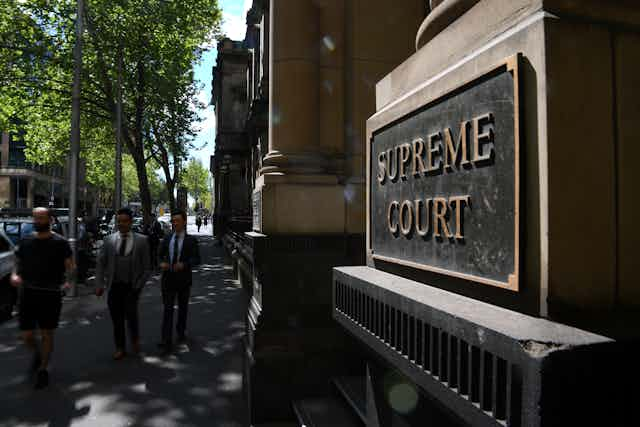In early September, Victoria Supreme Court Chief Justice Anne Ferguson issued a statement as COVID cases began to rapidly decline across the state following the peak of the second wave.
Ferguson said she and her colleagues would
carefully consider what changes we can make practically, safely and steadily in line with the easing of each level of restrictions.
For the hundreds of people languishing on remand in Victoria’s jails waiting for their cases to be heard, these changes can’t come quickly enough.
Coronavirus has dealt a blow to the already overburdened and slow-moving Victorian Supreme and County Court systems, where jury trials involving serious criminal offences are heard. Unless there are creative solutions put in place to deal with the backlog of cases caused by the pandemic, the old adage may prove true: justice delayed is justice denied.
How backlogged the system is
The court system was already quite backed up in Victoria — as it is in every state and territory.
In June, there were around 2,800 people in Victoria’s prisons waiting to be sentenced or on remand waiting for their hearing. That month, the County Court also estimated its backlog of cases to be 750.
Last year, the Productivity Commission found around 20% of criminal cases in Victoria’s Supreme and County Courts were over a year old.
This figure is likely to be far greater by the end of this year given criminal trials have essentially been stopped in these courts since March.
In other words, the backlog of cases will only continue to grow and the waiting time for suspected offenders, victims and witnesses to have their day in court will stretch out well into 2022.
New ways of thinking
Short of pleading guilty and hoping for a quick release from prison, or trying to jump over the hurdles of Victoria’s extraordinarily complex bail laws, there is little a person can do but wait.
And this is no doubt challenging for those on remand in prison. During COVID, family visits have been on hold and education and other programs have been sporadic at best.
Read more: Jury is out: why shifting to judge-alone trials is a flawed approach to criminal justice
But with every crisis comes opportunity: we can now make the necessary reforms to drag the criminal trial process into the 21st century.
To be fair, Victorian courts have begun tackling the COVID crisis. The County Court has, for instance, instituted an emergency case management system to help speed up its lengthy court processes.
But COVID presents a not-to-be-missed opportunity for permanent changes to be put in place, such as relying more on early dispute resolution, making better use of technology so the days of crowded courtrooms and long waiting times are a thing of the past, and implementing restorative justice instead of lengthy jail time for offenders.
Many criminal cases could avoid trial altogether
Early dispute resolution is a smart approach that has already been used in magistrates courts for some years now.
In this process, the prosecution and defence meet to discuss the issues of a case with the judge, the likelihood of conviction and what sort of sentence might be available if the suspected offender were to plead guilty. All criminal cases should be subjected to this process now.
The sort of aggressive case management that routinely occurs in the family law and commercial courts — where judges take a very interventionist role and lawyers are expected to be willing to compromise — should also be a permanent feature of the criminal justice process.
The days of prosecution and defence resolving cases only when the trial or hearing date is approaching must end.
Online hearings and judge appointments
Technology must also become a permanent feature of how all courts, including criminal trial courts in Victoria, do business.
In some ways, going to court has not changed since the 19th century. Courts sit from 9:30 or 10am until 4pm each day and generally require individuals, including lawyers, to be physically present for hearings.
Much court time is taken up with short hearings which are essentially about case management and setting timetables. This could be done outside court hours via video conference between legal representatives and the judge instead.
We should also use an appointment system for judges hearing cases. For example, it might suit the judge and the parties to hold a directions hearing online, rather than in the usual courtroom setting.

A new approach to sentencing
The greater use of restorative justice is another way of reducing court backlogs.
Restorative justice is an alternative to a traditional court process that involves victims being able to directly confront offenders who have pleaded guilty about the impact their crime has had on them.
It also forces offenders to come to terms with their crimes, rather than seeking to rationalise or minimise them. Those who take part are typically offered reduced jail time.
This can be particularly effective in historical sexual abuse cases where potential sentences are so high that defendants often proceed to trial rather than pleading guilty, hoping for an acquittal.
Read more: In historic cases, punishment alone is not always the best response to violent crime
Recent surveys in other countries show restorative justice to be very popular among victims. A 2018 survey for the New Zealand Department of Justice found 86% of victims were satisfied with the process, while a 2016 study in the UK found 60% of those who used restorative justice would recommend it to other victims of crimes.
The Victorian criminal justice process is a critical element of the state’s democratic fabric. But business as usual is not an option now that COVID has rendered a creaking system broken. It is the ideal time for realistic and overdue reforms to alleviate the backlog of cases and shorten the time people must spend in the court system.

